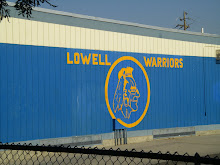It has always been interesting to me how certain themes materialize. They are not usually new, but they seem to come and go in waves. Sometimes more clarifying than original.
Two weeks ago a national legend in the world of neighborhood revitalization visited Fresno. Gus Newport is a former Civil Rights activist and the former Mayor of Berkeley. His real rise to prominence came through his work in the Boston neighborhood called Dudley Street. This neighborhood had been burned down by arsonists. Slumlords collected their fire insurance and left devastation. Industry followed by using vacant lots as hazardous waste dumping sites. Gus gathered the remaining neighbors together and used his political skills to get the attention of the Mayor and business leaders. Together they made huge strides to bring health back to the neighborhood.
The message Gus brought to Fresno was this: Many of the things that he fought for in the 1960's were flawed. Ideals like affordable housing had often created slums and ghettos. Housing was the goal, but without a mixture of uses like services, retail, jobs, and recreation, the end product was a disaster. Gus talked about the need for more holistic goals. What is a healthy neighborhood? A mixture of incomes, walkable places with good transportation. Education connected to employment opportunities. Financial knowledge coupled with banking. Access to living wages. Businesses that reinvested back into their communities. Parks that were active and fun.
Stefanos Polyzoides is the Managing Partner heading the Downtown Community Plan and the Fulton Corridor Specific Plan consulting team. He spoke to the Fresno Planning Commission last week to give them an overview of the planning efforts. His message was: Planning needs to include hisotric preservation, economic development, transportation, good design, community input, parks and landscape, infrastructure. Again, it is a holistic approach to what makes a healthy downtown and a healthy downtown neighborhood. This is what we are doing through our downtown plans in Fresno.
Contrast this theme with the recent application to add the Fulton Mall to the National Registar of Historic Places. A small group, operating in relative isolation, has submitted the application. There were no community meetings and there were no meetings of property owners to decide whether or not this was a good idea. The rules for adding a property or properties to the National Registar forbid commissioners to consider concepts like economics. This seperation of ideas was confirmed by commisioners on the State Hisotirc Preservation Commission. As long as preservation walls itself off from the concepts of economics and revitalization, it will continue to engender unnecessary opposition. The bizarre piece of the application was that it only included the Mall, not the historic buildings that surround it. If the applicants really wanted preservation, wouldn't they have included the buildings that are truly historic? Again, it is a limited perspective rather than a holistic view.
Over 25 years ago, the National Trust for Historic Preservation realized that saving buildings without addressing the economic realities required for revitaliztion, that more buildings would be lost. And by revitalizing downtowns, more buildings would find economic uses than could ever be saved on a one by one basis. The program they created called the National Main Street program was their most successful ever. The helped thousands of downtowns, districts and neighborhoods, while holding to an ethic of historic preservation.
Fresno has an opportuntiy to learn from all of this. Yes, we have affordable housing needs. But, putting all of our affodable housing in neighborhoods of concentrated poverty only solidifies their condition. Historic preservation is an ideal that succesful cities hold onto. They also know that revitalization of their urban areas is the best way to accomplish this goal, by finding ways to make their downtowns thrive and their older neighborhoods desirable for a wide variety of people.
Subscribe to:
Post Comments (Atom)




I think your right about the importance of holistic planning, but your framing of the Mall application doesn't seem to fit. Though the Fulton Mall historic application may not have been executed well, the blame shouldn't be placed on the applicants because they didn't involve the property owners. The Mall is public space and is functional(can be made more functional with smart infrastructure improvements). It is also distinct in style/time period from the surrounding buildings, so it's excusable that the buildings weren't included. Also, the nice buildings aren't in danger of being torn down, like the mall is. The Security Bank building is being worked on and the Bank of Italy building was just bought by a renowned developer, so there seems no danger of losing them.
ReplyDeleteThe application was attempting to protect a valuable public asset. Considering the history of redevelopment and the tendency to make bad decisions in the name of progress, this attempt shouldn't be scorned, but taken note of and engaged.
Good luck, it seems your working hard for the City and that is very commendable.